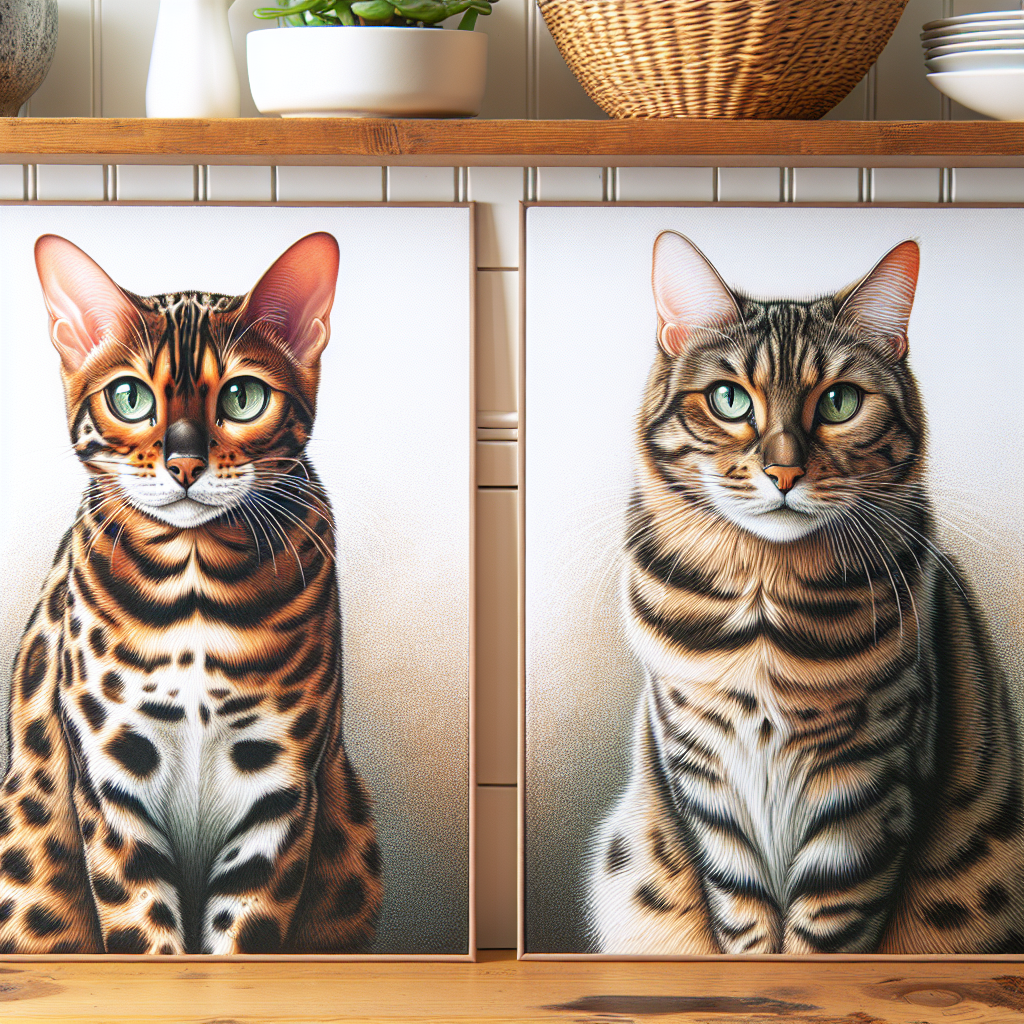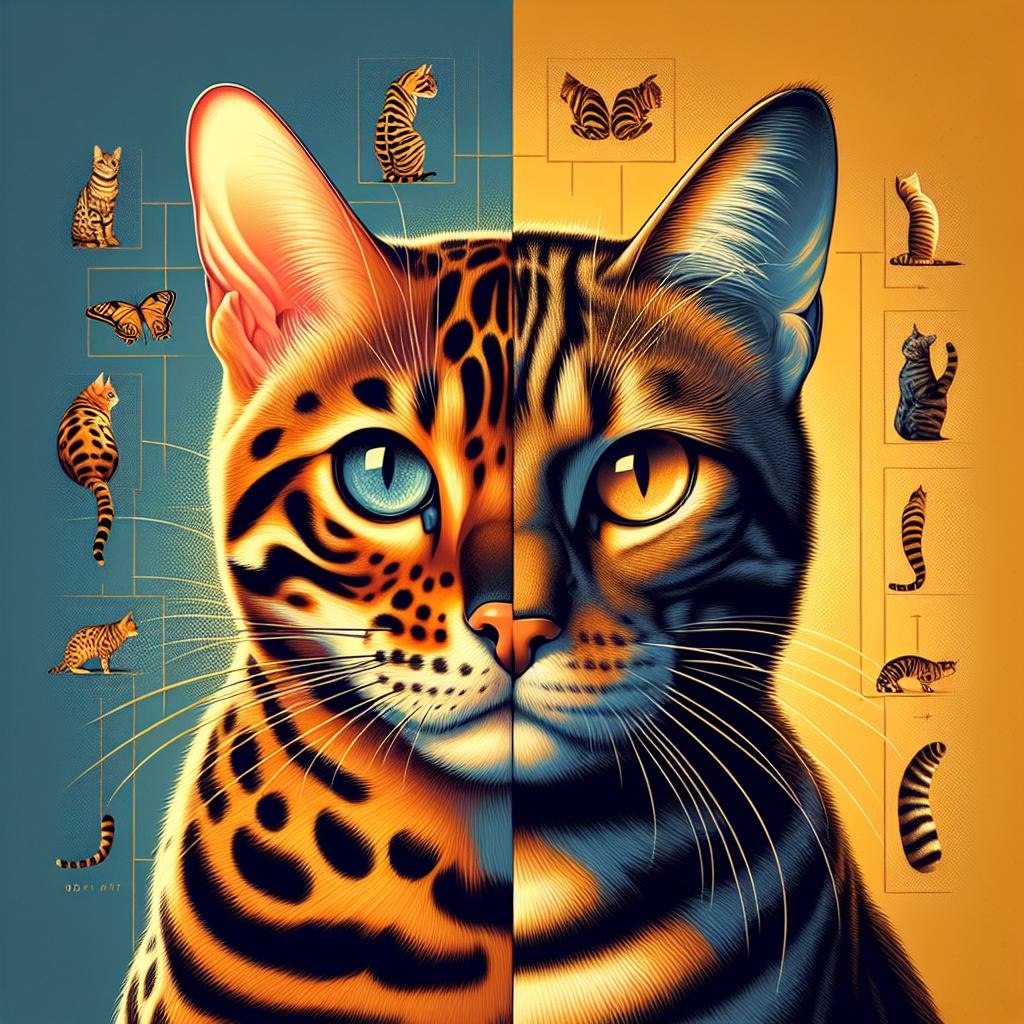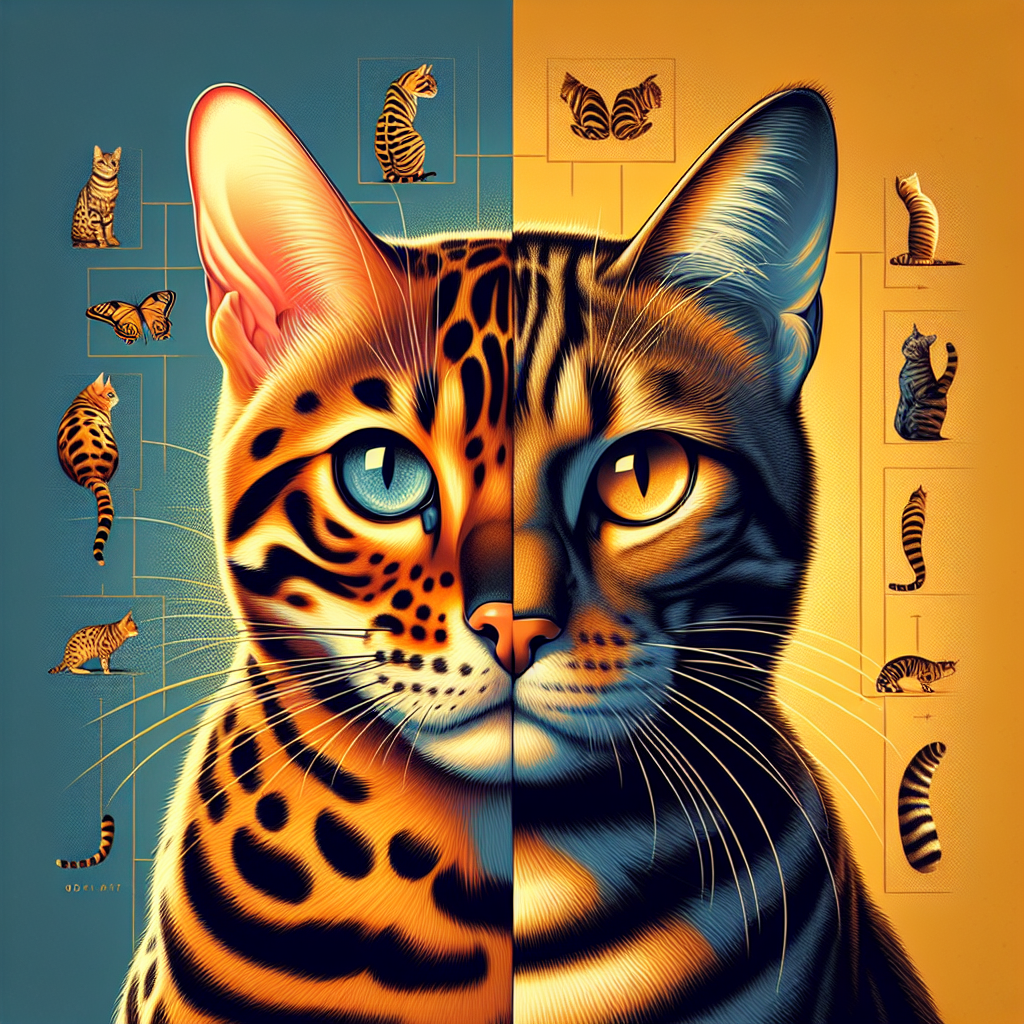Have you ever wondered about the breed of your beloved feline friend? In the world of cats, distinguishing between a Bengal and a Tabby can sometimes be a puzzling endeavor. With their distinct patterns and traits, it’s no wonder cat owners yearn to uncover the true identity of their furry companions. Whether you’re a seasoned cat enthusiast or a curious first-time owner, this article aims to shed some light on the key differences between these two popular cat breeds and help you determine if your cat is a Bengal or a Tabby.
Understanding Cat Breeds
Cats are fascinating creatures, each with their own unique characteristics and traits. Among the many breeds of cats, Bengal cats and Tabby cats are two popular and beloved choices for pet owners. If you have been wondering whether your cat is a Bengal or a Tabby, this article will help you gain a deeper understanding of these breeds, their differences, and how to identify them.
What is a Bengal cat?
Bengal cats are a breed known for their striking appearance, resembling the wild and majestic Bengal tiger. They have a muscular build and carry themselves with grace and elegance. One of the most distinctive features of Bengal cats is their beautiful coat, which is soft, silky, and typically covered in gorgeous spots or marbled patterns. Bengal cats are often sought after for their exotic looks and are considered a breed that stands out from the rest.
What is a Tabby cat?
Tabby cats, on the other hand, are not a specific breed but rather a coat pattern that can be found in various cat breeds. Tabby is a term used to describe the markings on a cat’s coat, characterized by stripes, spots, or swirls. These markings can come in a range of colors and are often seen in domestic shorthair cats. It is worth noting that not all Tabby cats are the same, and their appearance can vary greatly depending on their specific breed and lineage.

Differences between Bengal and Tabby
While both Bengal cats and Tabby cats have distinctive coat patterns, there are some notable differences between the two. Bengal cats typically have more intricate and defined markings, with spots or marbling that closely resemble those of a wild leopard or tiger. On the other hand, Tabby cats generally have more subtle patterns, such as classic or mackerel stripes, which can be seen on a variety of cat breeds.
In terms of body structure, Bengal cats tend to be more muscular and agile, reflecting their wild ancestry. They have a sleek and athletic build, making them excellent climbers and jumpers. On the other hand, Tabby cats come in various sizes and body types, depending on their breed. Some Tabby cats may be more compact and sturdy, while others may have a leaner and more sociable physique.
Appearance and Physical Traits
Distinctive characteristics of Bengal cats
Bengal cats have several distinctive physical traits that set them apart from other breeds. Their most notable characteristic is their coat, which often features beautiful and eye-catching spots or marbled patterns. The spots can vary in size and shape, giving each Bengal cat a unique and individual look. Additionally, Bengal cats have a muscular build, long and lean bodies, and a sleek and glossy coat. Their almond-shaped eyes, usually green or gold in color, add to their captivating and wild appearance.
Common traits of Tabby cats
Tabby cats, as mentioned before, are not a specific breed but rather a coat pattern found in many breeds. They can have various coat colors, ranging from brown, gray, or orange to black or silver. Tabby cats often have a distinctive “M” on their forehead, which is a characteristic trait of this coat pattern. In terms of body structure, Tabby cats can have different physique depending on their breed. However, they generally have a more average build compared to the sleek and muscular Bengal cats.
Recognizing similarities and differences
While Bengal cats and Tabby cats have distinct physical traits, there are also some similarities between the two. Both breeds can have a silky and soft coat, although the patterns and colors may differ. Both Bengal and Tabby cats can have a range of eye colors, including green, gold, or hazel. However, it is important to note that not all cats with tabby markings are considered Tabby breeds, as these markings can appear in various cat breeds.
Coat Patterns and Colors
Bengal coat patterns
Bengal cats are known for their unique coat patterns, which resemble those of their wild ancestors. The leopard-spotted pattern, also known as the “rosette” pattern, is one of the most desirable and sought-after coat patterns in Bengal cats. It consists of spots that are larger and more defined, shaped like a rosette or doughnut. Another common coat pattern seen in Bengal cats is the marble pattern, which creates a swirling or marbled effect on their coat. This pattern can vary in intensity and color, adding to the individuality of each Bengal cat.
Tabby coat patterns
Tabby coat patterns are diverse and can vary greatly depending on the breed and individual cat. Classic Tabby cats have bold and distinct stripes that run down their body from the neck to the tail, resembling the letter “M” on their forehead. Mackerel Tabby cats have thin parallel stripes that create a fishbone-like pattern, with vertical stripes on the body and horizontal stripes on the legs and tail. Ticked Tabby cats have a unique pattern where individual hairs are banded with different colors, giving the cat a “salt and pepper” appearance.
Variations in colors and combinations
Both Bengal and Tabby cats can come in a range of colors and combinations. Bengal cats often have a base color that ranges from golden, tawny, or sandy to silver or gray. Their spots or marbling can be black, brown, charcoal, or even a combination of these colors. Tabby cats, on the other hand, can have various coat colors, including but not limited to brown, gray, orange, black, or silver. The color and pattern combinations in both Bengal and Tabby cats contribute to their individuality and make each cat unique.

Temperament and Behavior
Bengal cat behavior traits
Bengal cats are known for their energetic and playful nature, often exhibiting behavior similar to their wild counterparts. They are highly intelligent cats and require mental stimulation and regular exercise to keep them engaged and satisfied. Bengal cats are often curious and adventurous, always seeking out new experiences and challenges. They are social cats that enjoy interaction and can form strong bonds with their owners. However, Bengal cats can also be independent and may exhibit some territorial behaviors if not properly trained and provided with a suitable environment.
Tabby cat behavior traits
Tabby cats, like Bengal cats, can exhibit a range of behaviors depending on their individual personality and breed. However, there are some common traits that can be observed in many Tabby cats. They are generally known for being affectionate and sociable cats, often seeking out attention and companionship from their owners. Tabby cats tend to be adaptable and can adjust well to different environments and households. They are often playful and curious, enjoying interactive toys and activities. However, just like any other cat, Tabby cats can have their own unique temperaments and may display individual preferences and behaviors.
Personality comparisons
When comparing the personalities of Bengal cats and Tabby cats, it is important to note that individual personalities can vary within each breed. That being said, Bengal cats are often more energetic and require more mental and physical stimulation compared to Tabby cats. They may have a higher prey drive and a greater need for playtime and exercise. Tabby cats, on the other hand, are generally known for their friendly and sociable nature, often enjoying the company of their owners and other pets. They are often described as easygoing and adaptable companions, making them well-suited for a variety of households.
Origins and History
History of Bengal cats
The Bengal cat breed has a relatively short but interesting history. They were developed from crosses between domestic cats and the Asian Leopard Cat, a small wild feline native to Asia. The goal was to create a domestic cat with the beautiful and exotic coat patterns of the Leopard Cat. The breed was officially recognized in the 1980s, gaining popularity for its striking appearance and unique heritage. Today, Bengal cats are recognized and admired for their distinctive coat patterns and have become a sought-after breed among cat enthusiasts worldwide.
History of Tabby cats
Tabby cats, as mentioned earlier, are not a specific breed but rather a coat pattern that can be found in many breeds. The term “Tabby” is believed to have originated from the Arabic word “attaabi,” which means ribbed or striped silk. Tabby cats have been depicted in ancient Egyptian art, suggesting that their distinctive coat patterns have been cherished for thousands of years. These cats eventually spread across Europe, becoming a common coat pattern seen in domestic cats. Today, Tabby cats are widely recognized and beloved for their charming and unique markings.
Development of the breeds
The development of the Bengal cat breed involved careful breeding programs and the selectivity of certain traits, such as the distinctive coat patterns and physical characteristics of the Asian Leopard Cat. These breeding programs aimed to create a domestic cat breed that closely resembled its wild ancestors while maintaining a loving and sociable temperament. Through successive generations of breeding and refinement, the Bengal cat breed emerged. Tabby cats, on the other hand, have developed naturally over time, with the coat pattern appearing sporadically in domestic cats through genetic variation and selection.
Genetics and Breeding
Genetic background of Bengal cats
Bengal cats have a unique genetic background due to their lineage from the Asian Leopard Cat. The breed was initially developed through hybrid crosses between the Leopard Cat and domestic cats, usually Egyptian Maus or Abyssinians. Since then, various other breeds, such as the Siamese and Burmese, have been used in breeding programs to diversify the Bengal gene pool and refine desired traits. Hybrid breedings require careful consideration and understanding of genetic compatibility to ensure healthy and well-adjusted kittens.
Genetic makeup of Tabby cats
Tabby coat patterns are not specific to a particular breed but can appear in various cat breeds. The Tabby coat pattern is believed to be inherited through a dominant gene, with variations in the expression of the pattern. However, the specific genes and mechanisms behind the development of Tabby patterns are still subjects of ongoing scientific research. It is important to note that while Tabby cats can be bred intentionally to preserve and enhance certain coat patterns, the primary focus is on the breed itself rather than the coat pattern alone.
Breeding considerations
Breeding Bengal cats and Tabby cats requires responsible breeding practices and careful consideration of various factors. Breeders should prioritize the health and well-being of the cats involved, ensuring they are genetically sound and free from hereditary health issues. When breeding Bengal cats, it is crucial to choose suitable mate pairs to maintain and enhance desired traits while avoiding potential health risks. Tabby cats, being a coat pattern rather than a breed, should be bred based on their individual breed standards to preserve the overall characteristics and temperament of the breed.
Popularity and Availability
Bengal cats as popular pets
Bengal cats have gained significant popularity in recent years as exotic and striking pets. Their unique appearance and resemblance to their wild ancestors make them highly sought after by cat enthusiasts around the world. However, it is important to note that Bengal cats require dedicated care, attention, and suitable environments to thrive. Due to their popularity, finding Bengal kittens may be relatively easier compared to some rarer breeds. However, it is recommended to seek reputable breeders who prioritize the health and temperament of their cats.
Tabby cats in households
Tabby cats, being a coat pattern rather than a specific breed, are more readily available and can be found in many households. They are popular choices for those seeking a friendly and affectionate companion without a specific preference for a particular breed. Tabby cats are often found in shelters and rescue organizations, as their coat pattern is quite common among domestic cats. Adopting a Tabby cat can be a wonderful way to provide a loving home to a deserving feline companion.
Availability and adoption
Both Bengal cats and Tabby cats can be found through various channels, including reputable breeders, rescue organizations, and shelters. When considering adopting a cat, it is important to prioritize the cat’s well-being and consider factors such as temperament, health, and compatibility with your lifestyle. Shelters and rescue organizations often have a wide variety of cats, including Tabby cats, waiting for their forever homes. Additionally, reaching out to breed-specific rescue groups or clubs can provide an opportunity to adopt a Bengal or Tabby cat in need of a loving family.
Caring for Bengals and Tabbies
Bengal cat care requirements
Bengal cats require specific care to ensure their well-being. Providing them with a stimulating environment that includes scratching posts, climbing trees, and interactive toys is essential to prevent boredom and destructive behavior. Bengals are active cats and need regular exercise, so providing opportunities for play and incorporating puzzle feeders can help keep them mentally and physically stimulated. Their coat also requires regular grooming to keep it free from mats and tangles. Additionally, Bengal cats thrive on a balanced and nutritious diet to maintain their overall health and vitality.
Tabby cat care guidelines
Tabby cats, like any other cat, require proper care and attention to lead happy and healthy lives. Regular veterinary check-ups, vaccinations, and preventive care are essential to maintain their overall health and well-being. Providing a balanced and age-appropriate diet, as well as fresh water, is important for their nutrition and hydration. Tabby cats should have access to scratching posts or pads to help them maintain their claws, as well as interactive toys to keep them mentally stimulated and engaged. Regular grooming, including brushing their coat and cleaning their ears and teeth, is necessary to keep them comfortable and prevent any potential health issues.
Similarities in maintenance
While Bengal cats and Tabby cats may have some differences in their care requirements, there are also many similarities. Both breeds need regular veterinary check-ups and vaccinations to ensure their health and prevent potential illnesses. Regular grooming is important for both breeds to keep their coats healthy and free from mats or tangles. Providing a suitable and enriching environment with toys, scratching posts, and climbing structures is beneficial for both Bengal and Tabby cats. Ultimately, caring for any cat, regardless of breed or coat pattern, requires love, attention, and providing for their specific needs.
Health Concerns
Common health issues in Bengals
Bengal cats, like any other breed, can be prone to certain health issues. They may have a higher risk of developing hypertrophic cardiomyopathy (HCM), a condition that affects the heart muscle. This genetic condition should be monitored by regular veterinary check-ups and diagnostic testing. Bengal cats may also be more susceptible to certain types of kidney disease. Responsible breeders carefully screen their cats for known genetic health issues to ensure the production of healthy kittens. Providing a balanced diet, regular exercise, and a stress-free environment can contribute to the overall well-being and longevity of Bengal cats.
Typical health problems in Tabbies
Tabby cats, being a coat pattern rather than a specific breed, can have varying health concerns depending on their breed and individual genetics. However, like all cats, Tabby cats may be prone to certain common conditions such as dental disease, obesity, and kidney disease. Regular dental care, including tooth brushing or dental treats, can help maintain good oral health. Maintaining a healthy weight through balanced nutrition and regular exercise is important to prevent obesity. Monitoring kidney function through regular veterinary check-ups and appropriate diagnostic testing can help catch any potential issues early on.
Preventive care and regular check-ups
Preventive care plays a crucial role in maintaining the health of both Bengal cats and Tabby cats. Regular veterinary check-ups, vaccinations, and diagnostic tests are essential to monitor their overall health and catch any potential issues early on. Maintaining a balanced diet, providing fresh water, and promoting exercise and mental stimulation are all important aspects of preventive care for cats. By taking a proactive approach to their healthcare, cat owners can ensure that their feline companions lead long, happy, and healthy lives.
Conclusion
Understanding the differences between Bengal cats and Tabby cats is important for any cat owner who wants to identify their beloved feline companion correctly. By examining their physical traits, coat patterns, temperament, and origins, it becomes easier to differentiate between the two breeds. Regardless of whether your cat is a Bengal or a Tabby, each cat is unique and deserves to be loved and cared for in its own individual way. If you are ever unsure about your cat’s breed or have any concerns, consulting with a veterinarian or cat expert will provide you with the guidance and information you need to ensure the well-being and happiness of your furry friend. Embrace the unique qualities of your cat, whether they are a Bengal or a Tabby, and enjoy the companionship and joy they bring to your life.

